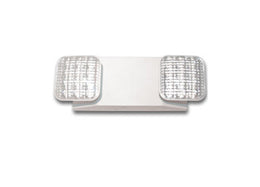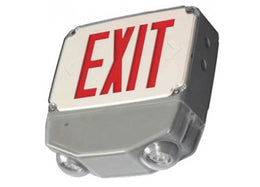Emergency Lights
LED Two Head Emergency Light - 90 Minute Battery- 5 Yr Warranty - UL Listed
Regular price
$22.99
$18.00
Black Thermoplastic LED Two Head Emergency Light - Battery - 5 Yr Warranty
Regular price
$25.00
$23.00
LED Two Head Emergency Light - 90 Minute Battery- 5 Yr Warranty - UL Listed - High Lumens
Regular price
$46.95
$35.00
Emergency Lights with Battery Back up
Are you prepared for emergencies? From power outages to fires, disasters can strike at any time. Having a response plan to facilitate navigation into safety is always essential. The best way to accomplish that is often with emergency lights that provide sufficient illumination of safety equipment and escape routes.
Exit Sign Warehouse offers top-of-the-range, stylish, cost-effective, and code-compliant emergency lights to ensure you’re well prepared for power outages and related disasters. Choose from a wide range of affordable and high-quality options for use in residential, industrial, or commercial buildings. Whether you need indoor or outdoor emergency lights, we got you covered.
What Are Emergency Lights?
Emergency lights are what they sound like. They are lighting solutions designed to illuminate key safety areas and the best exit route (paths of egress) out of a high occupancy building when a power outage or emergency strikes.
In a power blackout, having exit pathways and safety areas well-lit means people can safely and quickly get out. A situation where you’re stranded in pitch darkness with no idea how to navigate an unfamiliar building can be distressing and even mean life and death.
Functional emergency lighting is essential to any building’s life safety system. For this reason, investing in the best products is crucial. And Exit Sign Warehouse emergency lights are products you can rely on when the worst happens.
Code Requirements for Emergency Lighting
Installing emergency lights is not only ethically responsible but also necessary if you want to remain compliant with the various local, state, and international codes and standards.
Several governing bodies are mandated to set and enforce the requirements for emergency lighting in high occupancy buildings. They include:
- The Occupational Safety and Health Administration (OSHA): As a regulatory body under the Department of Labor, OSHA sets and enforces standards for emergency light brightness, maintenance, and performance to ensure safe and healthful working conditions.
- The National Fire Prevention Association (NFPA): According to the official NFPA website, the Life Safety Code “is the most widely used source for strategies to protect people based on building construction, protection, and occupancy features that minimize the effects of fire and related hazards.” Key regulations to follow with emergency lighting installation are contained in NFPA 101: Life Safety Code Section 7.9. Other NFPA codes to monitor include NFPA 70, NFPA 99, NFPA 110, and NFPA 111.
- The International Building Code (IBC) by the International Code Council (ICC): This code is mandated to set standards that safeguard people against hazards in the built environment (new or renovated). In particular, Chapter 10 of the code sets emergency egress lighting requirements
- Local Authorities: In addition to OSHA, NFPA, and IBC, we highly advise you to review and comply with the codes and regulations of your local jurisdiction, especially if you’re located in Chicago and New York.
While compliance with all applicable codes and standards is essential, the IBC and NFPA 101: Life Safety Code are the most widely enforced. They cover indoor and outdoor emergency lights' placement, performance, and maintenance.
As NFPA 101 7.9.2 stipulates, “Emergency illumination shall be provided for a minimum of 1½ hours in the event of failure of normal lighting. Emergency lighting facilities shall be arranged to provide initial illumination that is not less than an average of 1 footcandle and, at any point, not less than 0.1 footcandle, measured along the path of egress at floor level.” Another key requirement to keep in mind is that emergency lights must offer illumination for a minimum of 90 minutes after power is lost.
All emergency lights offered by Exit Sign Warehouse comply with applicable codes and standards—ensuring the highest quality and performance.
Types of Emergency Lights
Exit Sign Warehouse houses different types of emergency lights for all your needs and tastes. Are you conscious of how the color blends with your décor? We have white and black units to choose from. Looking for recessed emergency lights? Or perhaps surface-mounted ones? No sweat, we have both.
Our wide range of indoor and outdoor emergency lights means that they can be installed virtually anywhere you want on your building and for whatever purpose you need. But regardless of your pick, all products housed in our store are UL Listed for unquestionable quality standards and are code-compliant.
Light Source: LED Emergency Lighting
A typical emergency lighting unit comprises a light source and reflectors that focus the light for increased intensity. The light source is usually either some type of incandescent light bulb or light emitting diode (LED) clusters.
LEDs are the more popular choice—and for good reasons. They are cost-efficient, highly durable, energy-efficient, have a long lifespan, require minimal maintenance, and have reliable visibility.
Power Source: Emergency Lights with Battery Backup
Emergency lights with battery backup are programmed to light up when a building’s main power source goes off, illuminating safety equipment and escape routes.
You generally have a couple of options for emergency lights with battery backup, and here’s how they compare:
- Sealed Lead-Acid Batteries: With lead-acid batteries, you get better temperature resistance, a higher capacity, and a lower cost than NiCad batteries.
- Nickel-Cadmium (NiCad) Batteries: These units are smaller and lighter than their Lead alternatives. NiCad batteries charge faster and can be safely installed in any orientation. They also have a reputation for reliability and robustness.
- Nickel Metal Hydride (NiMH): The batteries are environment-friendly, small in size, have a higher capacity than NiCad batteries, and operate efficiently in extreme temperatures.
- Lithium: Lithium is as lightweight as batteries come. They also have a high energy density, relatively low self-discharge, and a high working voltage.
Installing emergency lights with battery backup is more of a must-have than a nice-to-have. The type of battery you pick depends on your usage.
For example, suppose you’re looking for outdoor emergency lights. In that case, your best bet is a unit designed to work efficiently under exposure to extreme temperatures and foul weather conditions.
We have several options of hardy, sleek, and reliable indoor and outdoor emergency lights that come in different designs, materials, and battery types. Find your pick and stay safe!










